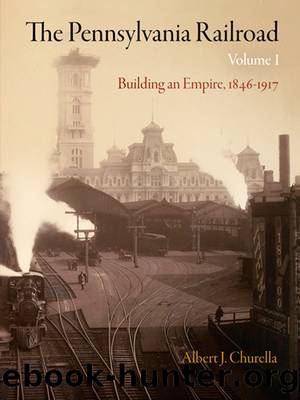The Pennsylvania Railroad, Volume 1 by Churella Albert J.;

Author:Churella, Albert J.;
Language: eng
Format: epub
Publisher: University of Pennsylvania Press
The West Shore, the Beech Creek, and the South Penn: Bankers and Railroaders
The conflict between the Pennsylvania Railroad and the New York Central began as an act of unscrupulous promotion that amounted to little better than extortion. For many decades, the NYC had operated a route from Manhattan north along the east bank of the Hudson River, and then west from Albany to Buffalo and, by way of the Lake Shore & Michigan Southern, to Chicago. Under the management of the Vanderbilt family, the NYC was an efficient and generally prosperous company, yet one that labored under the competition from the nearby Erie Canal and the Great Lakes. Given the high volume of water traffic flowing across New Yorkâto say nothing of the freight carried by the Erie and the other trunk linesâthere was little need for a new rail route through the region. Yet, two groups of promoters assembled a new rail link between New York and Cleveland, Ohio, with plans to proceed farther west to Chicago.
One threat to the NYC's interests emerged from the New York, West Shore & Buffalo Railway. The western side of the Hudson River, as far north as Albany, suffered from poor rail service and limited access to the NYC tracks on the opposite shore. During the 1870s, local entrepreneurs had attempted to build along the west shore, but with little success. In 1881, German-born financier Charles F. Woerishoffer joined forces with Edward F. Winslow (a cousin of Edward Winslow, of banking house Winslow, Lanier & Company), developing an audacious plan to complete the route and to extend it west to Buffalo, creating a new trunk line. One of Woerishoffer's biographers noted that the financier âhad the German ideas of open fight, and he attacked everything indiscriminately.â61 That seemed an apt description, for Woerishoffer and his associates proposed nothing less than to take on William H. Vanderbilt and the New York Central. They envisioned a 425-mile long, double-track railroad from Weehawken, New Jersey, to Buffalo, New York, paralleling the NYC for virtually the entire distance. In February 1880, the two entrepreneurs incorporated the West Shore, piecing together a series of railroads, dating back to the railway boom of the immediate post-Civil War period. The route followed the west shore of the Hudson River to Albany, and then turned east along the south bank of the Mohawk River (the NYC followed the north side) to Utica and points west. Woerishoffer and Winslow recruited sleeping car magnate George M. Pullman, along with one of Pullman's vice presidents, Horace Porter. Pullman and the Vanderbilt family had something of a history, and had not been on the best of terms since the NYC executives had subsidized efforts by Webster Wagner to develop sleeping cars. Wagner, as Pullman's chief competitor, had recently signed a contract with the New York Central, giving the Wagner Palace Car Company the exclusive right to operate sleeping cars throughout the NYC system. The West Shore project would afford Pullman the coveted opportunity to route his cars into the NYC's territory.
Download
This site does not store any files on its server. We only index and link to content provided by other sites. Please contact the content providers to delete copyright contents if any and email us, we'll remove relevant links or contents immediately.
| Automotive | Aviation |
| Motorcycles | Railroads |
| Ships |
Small Unmanned Fixed-wing Aircraft Design by Andrew J. Keane Andras Sobester James P. Scanlan & András Sóbester & James P. Scanlan(32151)
Navigation and Map Reading by K Andrew(4563)
Endurance: Shackleton's Incredible Voyage by Alfred Lansing(3859)
Wild Ride by Adam Lashinsky(1662)
And the Band Played On by Randy Shilts(1626)
The Box by Marc Levinson(1604)
Top 10 Prague (EYEWITNESS TOP 10 TRAVEL GUIDES) by DK(1572)
The Race for Hitler's X-Planes: Britain's 1945 Mission to Capture Secret Luftwaffe Technology by John Christopher(1533)
The One Percenter Encyclopedia by Bill Hayes(1471)
Girls Auto Clinic Glove Box Guide by Patrice Banks(1370)
Trans-Siberian Railway by Lonely Planet(1352)
Looking for a Ship by John McPhee(1325)
Batavia's Graveyard by Mike Dash(1307)
Fighting Hitler's Jets: The Extraordinary Story of the American Airmen Who Beat the Luftwaffe and Defeated Nazi Germany by Robert F. Dorr(1306)
Troubleshooting and Repair of Diesel Engines by Paul Dempsey(1289)
Bligh by Rob Mundle(1279)
TWA 800 by Jack Cashill(1257)
The Great Halifax Explosion by John U. Bacon(1234)
Ticket to Ride by Tom Chesshyre(1233)
